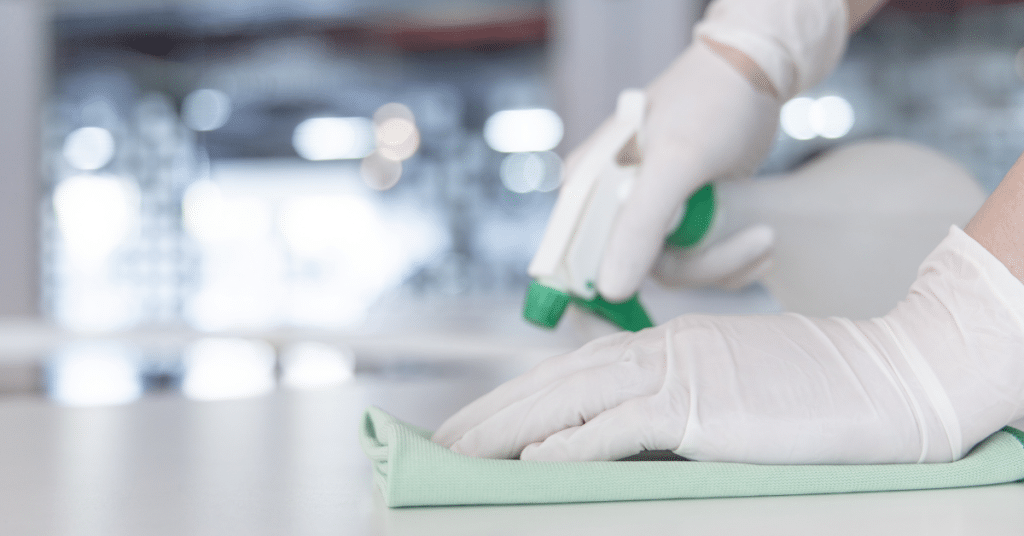In the quest for a germ-free home, understanding the science behind cleaning can make all the difference. By leveraging the principles of chemistry, you can effectively eliminate germs and create a healthier living environment. This blog post will delve into the chemistry of cleaning, offering practical tips and expert advice to help you clean like a scientist. With insights from cleaning professionals, you’ll discover how to harness the power of chemical reactions to achieve a truly germ-free home.

1. Understanding the Basics of Cleaning Chemistry
Cleaning is more than just removing visible dirt; it involves breaking down and eliminating harmful microorganisms. The key to effective cleaning lies in understanding the chemical reactions that occur between cleaning agents and contaminants.
Expert Advice:
- Surfactants: These are compounds that lower the surface tension of water, allowing it to spread and penetrate surfaces more effectively. Common surfactants include soap and detergents.
- pH Levels: The pH scale measures how acidic or basic a substance is. Cleaning agents with different pH levels are suited for different tasks. For example, acidic cleaners (like vinegar) are effective against mineral deposits, while alkaline cleaners (like baking soda) are great for cutting through grease.
- Oxidizing Agents: These chemicals, such as bleach and hydrogen peroxide, break down organic matter and kill bacteria through oxidation.
2. The Power of Vinegar and Baking Soda
Vinegar and baking soda are two of the most versatile and effective natural cleaning agents. Their chemical properties make them ideal for a wide range of cleaning tasks.
Expert Advice:
- Vinegar: Acetic acid in vinegar makes it effective at dissolving mineral deposits, cutting through grease, and killing bacteria. Use it to clean glass, countertops, and bathroom fixtures.
- Baking Soda: Sodium bicarbonate is a mild alkali that can dissolve dirt and grease in water. It also neutralizes odors and acts as a gentle abrasive. Use it to clean sinks, ovens, and as a deodorizer for carpets and refrigerators.
- Chemical Reaction: When vinegar and baking soda are combined, they create a fizzy reaction that can help dislodge dirt and grime. Use this combination to clean drains and remove tough stains.
3. Disinfecting with Bleach and Hydrogen Peroxide
Bleach and hydrogen peroxide are powerful disinfectants that can kill a wide range of pathogens. Understanding how to use them safely and effectively is crucial for maintaining a germ-free home.
Expert Advice:
- Bleach: Sodium hypochlorite in bleach is a strong oxidizing agent that can kill bacteria, viruses, and fungi. Use a diluted bleach solution (1 part bleach to 10 parts water) to disinfect surfaces like countertops, sinks, and toilets. Always ensure proper ventilation and avoid mixing bleach with other cleaners.
- Hydrogen Peroxide: This compound breaks down into water and oxygen, making it a safe and effective disinfectant. Use a 3% hydrogen peroxide solution to disinfect cutting boards, toothbrushes, and other household items. It’s also great for removing stains from fabrics.
- Contact Time: For both bleach and hydrogen peroxide, allow the disinfectant to sit on the surface for at least 10 minutes to ensure maximum effectiveness.
4. The Role of Enzymatic Cleaners
Enzymatic cleaners use natural enzymes to break down organic matter, making them highly effective for specific cleaning tasks. These cleaners are particularly useful for tackling pet stains, food spills, and other organic messes.
Expert Advice:
- How They Work: Enzymes are biological molecules that speed up chemical reactions. In cleaning products, they break down proteins, fats, and carbohydrates into smaller molecules that can be easily wiped away.
- Applications: Use enzymatic cleaners to remove pet urine stains, clean carpets, and eliminate odors from fabrics. They are also effective for cleaning drains and garbage disposals.
- Eco-Friendly: Enzymatic cleaners are biodegradable and non-toxic, making them a safe and environmentally friendly option for household cleaning.
5. The Science of Steam Cleaning
Steam cleaning harnesses the power of high-temperature steam to sanitize surfaces without the need for harsh chemicals. The heat from the steam kills bacteria, viruses, and dust mites, making it an excellent option for deep cleaning.
Expert Advice:
- How It Works: Steam cleaners heat water to produce steam, which is then directed onto surfaces through a nozzle. The high temperature of the steam breaks down dirt and kills germs.
- Applications: Use steam cleaners to sanitize floors, upholstery, mattresses, and bathroom fixtures. They are also effective for cleaning grout lines and removing stubborn stains.
- Safety Tips: Always follow the manufacturer’s instructions and use caution when handling hot steam. Ensure surfaces are suitable for steam cleaning to avoid damage.
6. The Benefits of Microfiber Cloths
Microfiber cloths are made from tiny synthetic fibers that can trap and remove dirt, dust, and bacteria more effectively than traditional cleaning cloths. Their unique structure makes them an essential tool for achieving a germ-free home.
Expert Advice:
- How They Work: The fibers in microfiber cloths create a larger surface area and can penetrate small crevices, making them highly effective at capturing particles.
- Applications: Use microfiber cloths for dusting, wiping down surfaces, and cleaning glass and mirrors. They can be used dry or dampened with water or a cleaning solution.
- Maintenance: Wash microfiber cloths regularly to maintain their effectiveness. Avoid using fabric softeners, as they can coat the fibers and reduce their cleaning power.
7. The Importance of Proper Ventilation
Proper ventilation is crucial for maintaining a healthy indoor environment. It helps remove airborne contaminants, reduce humidity, and prevent the buildup of harmful chemicals.
Expert Advice:
- Air Circulation: Open windows and use exhaust fans to promote air circulation and remove indoor pollutants. This is especially important when using chemical cleaners.
- Air Purifiers: Consider using air purifiers with HEPA filters to capture airborne particles and improve indoor air quality.
- Humidity Control: Use dehumidifiers to reduce humidity levels and prevent mold growth. Aim for a humidity level between 30-50% for optimal comfort and health.
8. The Value of Expert Advice
Consulting with cleaning professionals can provide valuable insights and personalized recommendations for maintaining a germ-free home.
Expert Advice:
- Professional Services: Consider hiring cleaning professionals for tasks that require specialized equipment or expertise, such as deep cleaning carpets or sanitizing upholstery.
- Stay Informed: Follow reputable cleaning blogs, websites, and social media accounts to stay informed about the latest cleaning techniques, products, and tools.
- Ask Questions: Don’t hesitate to ask cleaning professionals for advice and tips. They can provide personalized recommendations based on your specific needs and challenges.
Conclusion
Cleaning like a scientist involves understanding the chemistry behind cleaning agents and how they interact with contaminants. By leveraging the power of chemical reactions, you can effectively eliminate germs and create a healthier living environment. Whether you choose to use natural cleaners like vinegar and baking soda, powerful disinfectants like bleach and hydrogen peroxide, or innovative tools like steam cleaners and microfiber cloths, these strategies will help you maintain a germ-free home. Remember, the key to effective cleaning is knowledge, consistency, and a willingness to experiment with new techniques.
About The Author
Summit Cleaning is a premier cleaning service serving Westminster, CO and surrounding areas. We provide an array of professional cleaning services tailored to meet your residential needs. Our services include recurring maid services, deep house cleaning, and move-in/out cleaning services. Whether you’re in need of routine maintenance or a thorough cleaning, Summit Cleaning has you covered. Request for a home cleaning quote with us today and experience the difference in cleanliness for yourself.
Quote Form
← Next Blog Post: The Psychology of a Clean Home: How Tidiness Affects Your Mood

